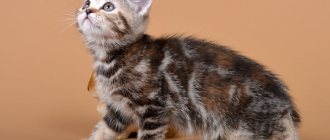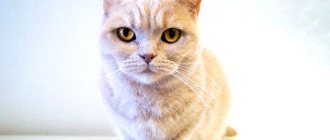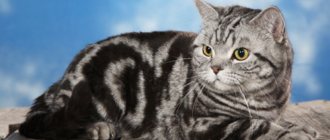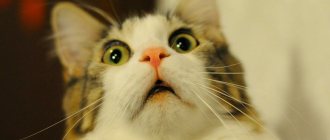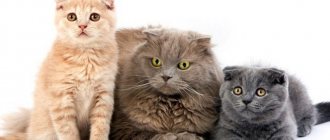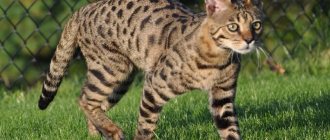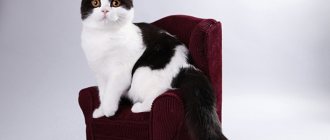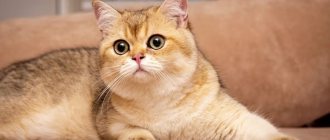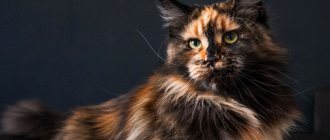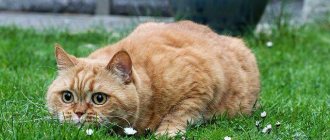Origin story
According to one version, British cats were brought by Roman legionnaires about 2000 years ago during the development of the islands of Great Britain. Another version interprets the French origin of this breed. There is no reliable data on who exactly brought these animals to the islands. History describes large gray cats among both Roman and French sailors, who were kept on ships to exterminate rodents. One way or another, the animals ended up in a separate territory, which allowed them to form their unique appearance. The damp and cold climate of England played a significant role in the evolution of the British breed. Due to constant winds and dampness, the wool became dense and thick. Hunting rodents has formed a strong body with developed muscles. Until the end of the 19th century, these animals were perceived as ordinary domestic cats.
In 1871, Harrison Weir organized the world's first cat show at the Crystal Palace in London . He proposed standardizing the breeds and introducing a point grading system. This time is considered the birth of the shorthaired breed . Harrison noticed that “aboriginal British” cats are different from others, they are larger, more massive, with special hair. In 1880, the first performance of these cats took place in London. In 1889, the first purebred shorthair cat was recognized. It was a white cat. In 1898, the first pedigree was issued. Until the beginning of the 20th century, selection did not divide shorthaired cats into British and European. The selection of representatives of the British breed began in the 30s of the 20th century. The official division of short-haired cats into British and European cats occurred in 1966.
The years of the First and Second World Wars affected the development of many breeds in Europe. The sharp decline in the number of British cats during the war and post-war times forced breeders to resort to interbreed matings to increase the population. Persian, exotic, chartreuse, Russian blue, European and American shorthairs were used in the breeding work. Thanks to the influx of new blood, by the beginning of the 20th century the British breed had several colors (solid, smoky, tabby, silver), although initially shorthaired cats in England were predominantly tabby. Crossing with the Persian breed quickly restored the population of large, strong animals, but fixed the gene for coat length, which gave a long-haired variation of the British breed, which is not recognized by all systems.
felinological system officially recognized the British Shorthair breed in 1980 as an independent breed with a ban on interbreed matings.
Diseases
Overall, this breed is hardy and healthy. But there are some genetic diseases and nuances.
- If you bring together cats with different blood groups - A and B - the kittens that are born will live only a few days. The point is this: the mother’s body transmits antibodies to the babies that destroy the blood cells of her babies. American researchers have come up with DNA testing for early ages; this is not yet available in other countries.
- Hypertrophic cardiomyopathy is an enlargement of part of the heart muscle that leads to heart attack and death. This disease can be identified by some characteristic signs: the animal becomes restless, stops running and jumping, it has shortness of breath and a specific cough. The disease cannot be cured, but its timely detection and drug therapy can prolong life for a significant period.
- The tendency to be overweight and obese is common, so teach your pet not to beg for pieces outside of school hours and not to overeat. Plan your diet and try to give your cat more physical activity.
- Tartar is another problem, not fatal, but unpleasant. Weak gums and bad teeth of British cats need to be taken care of from an early age, otherwise in 3-4 years some of the fangs will have to be removed. Take your pet to the veterinarian every six months for an examination and do not refuse professional teeth cleaning.
Young Britons have weak immunity and are easily susceptible to viral and infectious diseases, so don’t delay vaccinations. Rabies, panleukopenia, rhinotracheitis are dangerous diseases that take a long time to treat (or are not treated at all) and require significant financial costs. Annual comprehensive vaccinations will reduce the risk of infection. And don’t forget to give anti-worm medications quarterly!
Appearance
A strong, large, powerful British cat is difficult to recognize. The characteristic appearance sets this breed apart from other cats.
The British Shorthair and Longhair breeds have a strong, broad-boned, muscular, compact, well-balanced, stocky, medium to large sized body. The weight of adult cats is 4-6 kg, males - 5-8 kg. The formation of the backbone and growth of the British is long, formed by 2-3 years. The chest is wide. The back is straight and short. The shoulders are broad and massive, as are the hips. The limbs are short and strong with rounded paws. The tail is straight, short, thick at the base and rounded at the tip. In general, the impression of everything is large, compact and round.
The British breed's head attracts attention, distinguishing it from other breeds. Round, large with a wide skull . The ears are small, set wide and low, rounded at the tips, well furred on the outside. In profile, the rounded forehead “cup” turns into a straight, short, wide nose with a noticeable transition. The muzzle is round with full cheeks. Cheekiness is a distinctive feature of the British breed. Looking at the animal, one gets the impression of a smile. The cheeks are more developed in cats; cats have a less pronounced “girlish oval”. The chin is strong, smooth, and the nose forms a vertical line. The eyes are set wide, large, round, wide open. Eye color varies from honey, orange, yellow to blue and green depending on the color. The cheekbones are wide. The neck is short, thick, powerful.
The British Shorthair breed has a short, dense (thick) coat that does not lie close to the body, is not too soft, and is of equal length throughout the entire body (average length is 2.4 mm), with a well-developed undercoat and a fine texture that creates a feeling of “plushness .
Representatives of the long-haired variety have medium-length, straight hair with good undercoat and dry guard hair. The collar and panties are developed, the tail pubescence is long and luxurious. White and color point colors are not recognized in the British Longhair breed .
Eye color in black Britons
Among the variety of cats of the British breed, the following are distinguished:
- blue and purple shades;
- golden color, currently considered the most original and expressive;
- silver British cats, especially those with blue eyes;
- British chinchillas of all types of colors.
All Britons have blue eyes, but only up to four months. After this, the shade changes to gold. Some kittens may have green eyes, but breeders note that in this case the likelihood that the baby will turn black at the age of 6-7 months is zero.
Colors
There are more than 200 colors . Such diversity was formed during the periods of formation and revival of the British breed. Color selection continues to this day with the constant development of the breed.
Color assessment includes coat color, pattern, eye color, paw pad color and nose color.
Solid colors
Uniform color throughout the body. Solid colors do not allow spots, shades, white hairs or patterns . The coat is thick, short, and every hair is evenly colored from root to tip. The eyes are only orange, yellow, amber, copper, honey. For white solids, not only yellow eye color is possible, blue or odd-eyed is also acceptable. There are 9 solid colors :
- Black(n)
- Blue (a)
- Chocolate (b)
- Lilac (c)
- Red (d)
- Cream (e)
- White (w)
- Cinnamon (o)
- Faun (p)
Tortoiseshell colors (Tortoise, Tortoiseshell, Turtle)
A combination of genetically black and red colors. Only cats have this coloring . With chromosomal mutations, cats with trisomy may be tortoiseshell, but they are unable to reproduce. The eyes are always yellow (gold, copper, orange). The coat is thick and dense. “Turtle” is a unique color for breeding, since these cats produce a wide range of colors in their offspring.
- Black tortoiseshell (f)
- Blue-cream tortoiseshell (g)
- Chocolate cream tortoiseshell (h)
- Lilac-cream tortoiseshell (j)
Patterned or tabby colors (Tabby).
There is a pattern against the background of the main color. There are three tabby colors : marbled (classic), brindle (mackerel), spotted (spotted). What unites this group is the color of the head. All of them have the features of a tabby - the outline of the nose, eyes, a “scarab” on the top of the head, the letter “M” on the forehead . Eye color can be any in accordance with the color.
- Marble color (code 22) – a clear pattern in the form of wide lines. Large stripes run along the back from the withers to the tail. Several necklaces are attached to the neck. A “butterfly” pattern can be formed on the shoulder blades and curls can be located on the sides. There are 2-3 wide rings on the tail.
- Brindle color (code 23) - stripes are narrower, starting from the center line on the back and descending in narrow stripes on the sides. The necklaces on the neck are thinner, the tail is striped.
- Spotted color (code 24) – against a lighter background of the main color, clear contrasting spots are evenly located throughout the body. They can be round, oblong, or in the form of rosettes. There are spots on the limbs and preferably on the tail (open rings are acceptable).
Tipped colors (tipping, tipping)
This is a group of colors in which the hair has two or several zones of coloring (necessarily light at the root and dark towards the tip). There are two types of tipping: with and without silver (gold).
Silver tipped colors (s is added to the encoding):
- Smoky color (smoke). British smoke-colored cats have short, thick, coarse hair, each hair of which is painted 2/3 pure silver (almost white) from the root, including the undercoat. The remaining 1/3 of the hair towards the tip is colored in the main color (black, blue, red, etc.). The eyes are necessarily copper or orange. The nose and paw pads correspond to the color of the main color. Smoky is always a solid color and has no pattern.
- Shaded color (shaded, 11). 1/6 of the hair at the tip is dyed in the main color, the rest is silver. British cats have green or bluish-green eyes. Orange or copper eyes are possible - this color is called Pewter, with the obligatory indication of the eye color coding. The nose and paw pads correspond to the color of the main color. Red, cream, tortoiseshell shaded colors are called Cameo.
- Veiled color (shell, 12). 1/8 of the hair at the tip is dyed, the rest is silver. Chinchillas have green eyes. The nose and paw pads correspond to the color of the main color. The first chinchilla was bred in 1970 by Norman Winder in England after crossing a Persian chinchilla and a British shorthair. In 1973, it was exhibited for the first time at a cat show, where the breed was named British Black with Tipping. The color was officially recognized in England in 1980. Red, cream, tortoiseshell veiled colors are called Cameo.
Golden tipped colors (y is added to the encoding):
- By analogy with silver colors, golden Britons can be shaded, when 1/6 of the hair is dyed at the tip, or veiled (1/8 of the hair). The main background is from pale apricot to dark brick with transitions to black. The nose is brick-colored, the paw pads are black or dark brown. The eyes are only green.
- Shaded and veiled colors are colors that seem to be coated. Looking at these cats, it seems as if the animal was sprinkled with black powder on top (or another color depending on the main color). They do not have closed rings on the neck and limbs, and there should be no residual pattern. A dark outline of the nose and eyes is required.
Color point colors
This group of colors is recognized only in the British Shorthair variety, not in the Longhair variety. Color-points have a lightened body and darker areas - points (areas with low body temperature - muzzle, tail, ears, limbs, scrotum). Like solid colors, they are distinguished: seal-point - black, blue-point - blue, chocolate-point - chocolate, lilac-point - lilac, red-point - red, cream-point - cream. Patterned tabby color points are not divided into classic ones, since the pattern is quite blurred. They are combined into the links-point color. The eye color of British pointing cats is only blue .
Bicolor colors
British shorthair and longhair breeds have all possible combinations of white and any main color - the bicolor group. Based on the area of white color from maximum to minimum, Vanov, Harlequins, and Bicolors are distinguished.
- Van has the maximum amount of white. Completely white body and limbs. Only the tail and the “cap” on the head are colored in the form of one or two separate spots (ideally), always affecting one ear.
- Harlequin. A fifth of the surface of the body is colored, the rest is white. The tail, the “cap” on the head with the obligatory inclusion of one ear, and spots on the back and/or sides must be colored. A white collar is required.
- Bicolor. Half of the entire surface of the body has a basic color and can be located in one continuous area or have an island appearance. For bicolors, the placement of white is mandatory on the muzzle in the form of an inverted “V”, on the chest and lower part of the body, on the hips and legs in the form of “slippers”. A white collar is also desirable.
The British breed is not allowed to have white medallions or white paws.
Catering
Your pet's diet should be balanced and healthy. And this is not food from your table (even if you adhere to the principles of reasonable nutrition) and not cheap economy class food.
Natural products
If you want to feed your pet natural products, the menu should include:
- Lean meats: veal, beef, turkey, chicken, rabbit, horse meat, rabbit meat. You can give day-old chicks and mice. The meat is fed daily, first frozen in the freezer for 2-3 days, and scalded with boiling water before serving (to destroy pathogens and parasite larvae).
- Fish, but only once a week, a small piece. The following varieties are allowed: flounder, salmon, hake, trout, navaga, halibut. 2-3 times a month you can pamper your cat with boiled squid and peeled shrimp, scallops, and mussels.
- Fermented milk products: hard cheeses, natural yoghurts, curdled milk, sour cream, cream, fermented baked milk, goat milk. If a cat has been drinking cow's milk since childhood and has no problems with bowel movements, do not deny him this pleasure.
- Porridges cooked in water and without seasonings: rice, buckwheat, millet, oatmeal. Liquid semolina porridge with a small amount of milk and honey is given to very young children. Adults add half a teaspoon of vegetable oil (olive, flaxseed, sunflower) and mashed boiled chicken yolk (or a whole quail egg) to the prepared porridge.
- Boiled (stewed) vegetables: carrots, pumpkin, zucchini, asparagus, broccoli, fresh herbs (dill, parsley). If a cat gnaws on fresh cucumbers or radishes in the garden beds, this is also normal.
Remember what not to give:
- Fatty or rotten meat, meat with fatty layers and bones (even boiled), wild bird meat (it almost always carries parasite larvae), pork, lamb.
- River fish, fish raised in aquatic farms, with bones and fins.
- Offal (preferably boiled): kidneys, liver, spleen, ventricles, hearts, udders.
- Salty, fried, sweet, sour, smoked dishes.
- Potatoes, eggplants, grapes, dried fruits, citrus fruits, onions, garlic, chocolate, baked goods, flour.
- Products with dyes, GMOs, harmful food additives.
Do not mix dry food and natural food! This threatens to disrupt the functioning of the digestive system, liver and kidneys!
The British Longhair cat definitely needs sprouted grass to cleanse its stomach. Otherwise, he will gnaw on everything that seems suitable: flowers on the windowsill, dried flowers in vases, and even brooms.
Recommended food
If your cat prefers ready-made food, dry or wet, buy food from the holistic and super-premium classes. Judging by numerous reviews from animal owners, it is these foods that more than others meet all the necessary nutritional requirements.
Holistic foods include Power of Nature, Grandorf, Carnilove. Super premium food is Arden Grange, Fitmin For Life, Brooksfield.
Below are recommended super-premium foods. Links with the names of the food are clickable, on them you can, within our website, get acquainted with the descriptions of the food and read reviews from owners of British Longhair cats.
| Holistic | Super premium | Super premium |
| Now Natural Holistic | Meglium | Grandin |
British longhairs drink only water, purified from all harmful impurities such as bleach and salts, at a comfortable temperature (not from the refrigerator, but not hot either). Clean the liquid by settling it in advance, or use a household kitchen filter. There is no need to boil it.
Character
The British breed is known for its balanced, aristocratic, intelligent character. They are quite independent and get along with people and other animals. Little curious. When guests come to the house, they try to hide in a secluded place in order to avoid unnecessary attention to their person.
They are not inclined to show aggression and are patient. They are trusting and attached to their owner, prefer to be close to him at a distance, but do not particularly like to be held. The British breed represents the ideal unobtrusive companion with a phlegmatic and calm temperament. This is a cat that is “on its own”, not fussy, measured, and a little talkative. Adult animals moderately love to play, are more lazy and prefer to sleep than run around the apartment. The British are smart, stubborn and calm, but touchy. Having offended your pet, you will have to win his favor with affection and attention.
Buy a British cat
Having fallen in love with charming British cats, you will definitely want to have one in your home. Together with the charming creature, the owner receives a good, loving and kind friend who will be a joy for the whole family.
People do not always take the issue of purchasing a domestic purebred cat seriously. A true purebred British kitten can only be bought in a nursery, where they are bred by professionals and guarantee the impeccability of the breed's genes. Although in nurseries the price of kittens will be higher than on Avito, in the end you will save much more nerves and money in the future.
The wonderful British baby will immediately find a place in the heart of the new owner, demonstrating all the features of the aristocratic breed.
Care and maintenance
Unobtrusive, balanced British cats are easy to care for . Perhaps this is one of the most unpretentious breeds. The main task of the future owner is to maintain healthy coat quality, care for the ears and eyes. Due to the dense, thick undercoat, regular brushing is necessary, and daily during the shedding period.
Periodically you need to wash the animal using professional cosmetics. Regular grooming helps prevent the development of bezoars (wool stones in the animal’s digestive system), since the animal constantly licks itself, and wool entering the digestive tract can cause inflammation.
The British breed is moderate in its physical activity, therefore it is prone to obesity. A balanced diet, feeding regimen and regular exercise will allow the animal to be healthy and in great shape. Provide your pet with toys, a scratching post, and a climbing and play area.
Upbringing
Purchasing a kitten usually begins with a reservation. Then, only from 2 months of age the animal can be given to new owners. Why do you have to wait so long? Kittens, like children, are connected with their mother for the first time after birth, and not only with food. Mom teaches them the first steps and many other things that are invisible to us humans. After 2-3 months, the kitten is ready to leave its mother and move to a new family to live independently. In addition, during these 3 months, breeders teach kittens the litter tray, diet and scratching post.
After the kitten has moved to a new home, it needs to continue to be raised. You need to feed your pet in one specific place and at the same time. After moving, the toilet must first be installed in a visible place for the kitten so that he understands that his litter box is with him. The tray should be gradually moved towards the toilet, and after some time the kitten will only go to its tray in the place where it is convenient for you.

